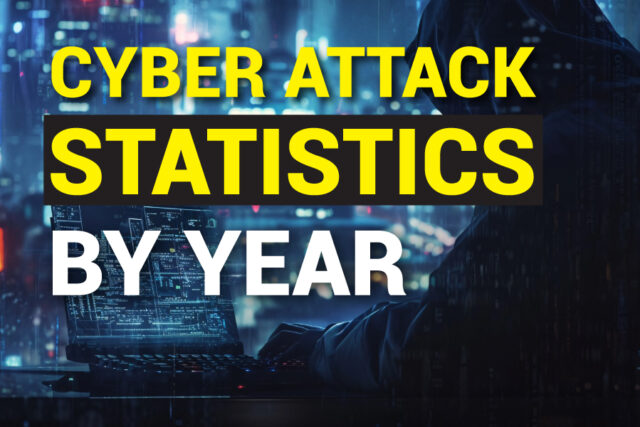In the digital age we live in, cyber attacks have become an ever-present threat, lurking in the shadows of our interconnected world. As technology continues to advance, so too do the sophisticated tactics employed by cybercriminals, making it crucial for individuals and businesses alike to stay vigilant. In this comprehensive article, we will delve into the alarming cyber attack statistics by year, shedding light on the evolving landscape of cybersecurity threats and the urgent need to prioritize online safety.
The realm of cybersecurity is a complex and ever-changing battleground, where hackers and security experts engage in a constant game of cat and mouse. From data breaches and ransomware attacks to phishing scams and distributed denial-of-service (DDoS) assaults, the methods employed by cybercriminals are as varied as they are insidious. It is our responsibility to stay informed and proactive, arming ourselves with the knowledge and tools necessary to navigate this digital minefield.
As we embark on this journey, we will explore the staggering statistics that paint a sobering picture of the cybersecurity challenges we face. From the meteoric rise in ransomware incidents to the staggering financial losses incurred by businesses and individuals, these numbers serve as a stark reminder of the importance of cybersecurity vigilance. Together, we will unravel the complexities of this ever-evolving threat landscape, empowering you with the knowledge and strategies to safeguard your digital assets and protect your online identity.
Importance Of Understanding Cyber Attack Statistics
Comprehending cyber attack statistics is paramount for several reasons. Firstly, it sheds light on the magnitude and gravity of the issue, enabling us to grasp the scale of the problem. Secondly, analyzing these statistics can reveal patterns and trends, allowing us to anticipate and prepare for potential threats. Thirdly, understanding the impact of cyber attacks on businesses and individuals underscores the urgency of implementing robust cybersecurity measures. By delving into these statistics, we can make informed decisions and take proactive steps to safeguard our digital assets.
Cyber Attack Statistics By Year: An Overview
Cyber attacks have been on a relentless rise, with each passing year bringing new and more sophisticated threats. Let’s embark on a journey through the alarming statistics that have unfolded over the years, painting a sobering picture of the cybersecurity landscape.
The Evolution Of Cyber Attacks Over The Years
- 2018: According to the Ponemon Institute’s “2018 Cost of a Data Breach Study,” the average cost of a data breach for companies was $3.86 million, a staggering 6.4% increase from the previous year.
- 2019: The Identity Theft Resource Center reported a total of 1,473 data breaches, exposing a staggering 164.68 million sensitive records.
- 2020: The COVID-19 pandemic ushered in a new era of cybersecurity challenges, with a 238% rise in cyberattacks targeting banks and a 600% increase in cloud cyber attacks, as reported by the Boston Consulting Group.
- 2021: The Identity Theft Resource Center revealed that the number of data breaches in the United States hit a record high of 1,862, a 68% increase from the previous year.
- 2022: According to the Cybersecurity Ventures report, global cybercrime costs are projected to reach a staggering $8 trillion, a figure that highlights the immense financial burden imposed by these attacks.
Key Findings From Recent Cyber Attack Statistics
- Ransomware attacks: Ransomware attacks have skyrocketed, with the FBI reporting a 62% increase in reported incidents in 2021 compared to the previous year.
- Supply chain attacks: Attacks targeting software supply chains have become more prevalent, with the SolarWinds and Kaseya incidents serving as stark reminders of their far-reaching consequences.
- Phishing and social engineering: Phishing remains one of the most common attack vectors, with the Anti-Phishing Working Group reporting a 51% increase in phishing attacks in 2021.
- Cloud vulnerabilities: As organizations increasingly adopt cloud services, cloud-based attacks have surged, with the Cloud Security Alliance reporting that nearly 70% of organizations have experienced a cloud security incident.
Common Types Of Cyber Attacks
To better understand the threats we face, let’s examine some of the most prevalent types of cyber attacks:
- Malware: Malicious software designed to disrupt, damage, or gain unauthorized access to computer systems. Examples include viruses, worms, Trojans, and spyware.
- Distributed Denial of Service (DDoS): Overwhelming a system or network with traffic from multiple sources, rendering it inaccessible to legitimate users.
- SQL Injection: Exploiting vulnerabilities in web applications by injecting malicious code into entry fields, allowing attackers to access or manipulate sensitive data.
- Phishing: Deceiving individuals into revealing sensitive information or installing malware through fraudulent emails, websites, or messages.
- Man-in-the-Middle (MitM): Intercepting and potentially altering communications between two parties, enabling eavesdropping or data theft.
Understanding The Impact Of Cyber Attacks On Businesses And Individuals
The consequences of cyber attacks extend far beyond mere statistics. These attacks can have devastating effects on businesses and individuals alike.
For businesses, cyberattacks can result in financial losses, reputational damage, operational disruptions, and legal liabilities. The theft of intellectual property, trade secrets, and customer data can erode competitive advantages and undermine consumer trust. Additionally, the recovery efforts and remediation costs associated with cyber incidents can strain budgets and divert resources from core business operations.
For individuals, cyber attacks can lead to identity theft, financial fraud, and the compromise of personal data. The emotional toll of such incidents cannot be understated, as victims often experience anxiety, stress, and a violation of their privacy. Furthermore, the recovery process can be time-consuming and emotionally taxing, with potential long-term implications for credit scores and financial well-being.
The Role Of Cybersecurity In Combating Cyber Attacks
In the face of these mounting threats, the importance of robust cybersecurity measures cannot be overstated. Cybersecurity encompasses a wide range of practices, technologies, and strategies aimed at protecting systems, networks, and data from unauthorized access, misuse, or theft.
Effective cybersecurity involves a multi-layered approach that includes:
- Risk assessment: Identifying and evaluating potential vulnerabilities and threats to an organization’s digital assets.
- Access controls: Implementing measures to ensure that only authorized individuals or entities can access sensitive information or systems.
- Encryption: Protecting data through the use of complex algorithms that scramble information, rendering it unreadable to unauthorized parties.
- Firewalls: Establishing barriers between trusted and untrusted networks to monitor and control incoming and outgoing network traffic.
- Incident response and recovery: Developing plans and procedures to detect, respond to, and recover from cyber incidents effectively.
Cybersecurity is not a one-time effort but an ongoing process that requires continuous vigilance, adaptation, and investment. As cyber threats evolve, so too must our defenses.
Tips For Protecting Yourself And Your Business From Cyber Attacks
While cybersecurity is a complex and ever-changing landscape, there are practical steps that individuals and businesses can take to enhance their protection:
Implement strong password practices: Use unique, complex passwords for each account, and consider using a password manager to securely store and manage them.
Keep software up-to-date: Regularly update operating systems, applications, and security software to address known vulnerabilities and patch security flaws.
Exercise caution with emails and links: Be wary of unsolicited emails, attachments, or links, as they may be phishing attempts or contain malware.
Enable multi-factor authentication: Implement additional layers of security, such as biometrics or one-time codes, to verify user identities.
Regularly back up data: Maintain frequent backups of critical data to ensure recovery in case of a cyber incident or data loss.
Provide cybersecurity training: Educate employees on cybersecurity best practices, including identifying and reporting potential threats.
Invest in cybersecurity solutions: Implement appropriate security measures, such as firewalls, antivirus software, and intrusion detection systems, tailored to your organization’s needs.
The Future Of Cybersecurity And The Need For Continuous Vigilance
As technology continues to evolve, so too will the cybersecurity landscape. Emerging technologies like artificial intelligence, the Internet of Things (IoT), and 5G networks present new attack vectors and challenges. Cybercriminals are constantly adapting their tactics and exploiting vulnerabilities in innovative ways.
To stay ahead of these threats, a proactive and adaptable approach to cybersecurity is essential. This includes:
- Continuous monitoring and threat intelligence: Actively monitoring for potential threats and leveraging threat intelligence sources to stay informed about emerging risks.
- Collaboration and information sharing: Fostering collaboration and information sharing among organizations, industries, and governments to combat cyber threats collectively.
- Investment in research and development: Supporting research and development efforts to advance cybersecurity technologies and strategies.
- Cybersecurity education and awareness: Promoting cybersecurity education and awareness campaigns to empower individuals and organizations to recognize and mitigate risks.
By embracing a culture of continuous vigilance and proactive cybersecurity measures, we can better navigate the ever-evolving threat landscape and safeguard our digital assets.
Conclusion
The alarming cyber attack statistics by year serve as a sobering reminder of the pervasive and escalating nature of cybersecurity threats. As we delve deeper into the digital age, the importance of understanding and addressing these threats cannot be overstated. By analyzing the evolution of cyber attacks, their impact on businesses and individuals, and the role of cybersecurity in combating these threats, we can better prepare ourselves for the challenges ahead. Implementing robust cybersecurity measures, fostering a culture of vigilance, and staying informed about emerging threats are crucial steps in protecting our digital assets and safeguarding our online presence.
Remember, cybersecurity is not a one-time effort but an ongoing journey that requires continuous adaptation and proactive measures. By embracing this mindset and taking practical steps to enhance our defenses, we can navigate the ever-changing cybersecurity landscape with greater confidence and resilience. To learn more about protecting yourself and your business from cyber threats, visit our comprehensive cybersecurity resource center. Explore our range of services, including risk assessments, security audits, and customized cybersecurity solutions tailored to your specific needs. Stay ahead of the curve and safeguard your digital assets with our expert guidance. Contact us today to schedule a consultation and take the first step towards a more secure digital future.














